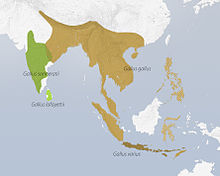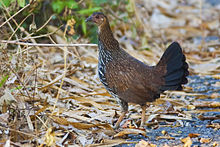Sonnerace Chicken
| Sonnerace Chicken | ||||||||||
|---|---|---|---|---|---|---|---|---|---|---|

Sonnerati cockerel ( Gallus sonneratii ) |
||||||||||
| Systematics | ||||||||||
|
||||||||||
| Scientific name | ||||||||||
| Gallus sonneratii | ||||||||||
| Temminck , 1813 |

The Sonnerathuhn ( Gallus sonneratii ) is a species of fowl from the pheasant-like family (Phasianidae). It inhabits the southwestern part of India . The species replaces the closely related Bankiva chicken , but the areas overlap in some regions and there are hybrids between the two species. The distribution extends in the north to eastern Gujarat , southern Rajasthan and the center of Madhya Pradesh , eastwards to about the eastern Ghats , in Andhra Pradesh also to the coast.
The species was named in honor of the French naturalist Pierre Sonnerat (1748–1814). In addition to the bankiva chicken, which is considered to be the ancestral form of the domestic chicken , genetic influences of the sun chickens could also be responsible for certain characteristics of the domesticated forms. The question has long been controversial; the genetic findings are sometimes different here.
description
The suntan chicken is slightly larger than the bankiva chicken. In males, the body length is between 70 and 80 cm, the weight between 790 and 1139 g, females are about 38 cm long and weigh between 705 and 790 g. The wing length of the male is 220 to 255 mm, the tail length 314 to 390 mm and the length of the tibiotarsus between 70 and 80 mm. In females, these dimensions are 190 to 215 mm (wings), 100 to 170 mm (tail) and 60 to 67 mm (tibiotarsus). The sexes differ significantly in plumage. During the breeding season, the rooster wears a splendid dress with elongated neck feathers ("neck hangings"), rudder feathers and a striking comb. After the breeding season, it throws off the long feathers of the neck hangings and the control feathers and shows a plain dress for some time. The iris is yellow to orange in both sexes, the beak horn-colored blackish and lightened yellowish at the tip and lower beak. Legs and feet are yellow to salmon red. The rooster has a long spur that is usually absent in the female.
Overall, or from a distance, the species appears to be much grayer than other comb grouse, such as the Bankiva chicken in particular, which is also indicated by the English name "Gray Junglefowl".
In the rooster, the crest , the featherless eye area, the chin and the wattles are colored red. In the area of the ear covers there is a small, white feathered field. The crest is only slightly jagged. The "neck hangings" made of elongated feathers appear dotted. The individual black feathers have a gray border, just above the tip two to three whitish and at the tip a yellowish horn plate. The back and rump feathers are black with a purple sheen, lanceolate, pointed with white shaft lines and narrow gray hems. The feathers on the underside are patterned in the same way, but show a washed-out rust-red color on the flanks. The black wing covers follow the pattern of the back, but the middle arm covers have elongated, orange-yellow horn tips. Large arm covers and wings are blackish brown. The hanging feathers of the rump are provided with rust-red tips and large yellow horn plates. Upper tail covers and control feathers are black with a purple sheen.
In hens, head and neck feathers are brownish with dark brown borders and a light, dark-edged center. The spring centers become larger towards the chest. The feathers on the underside are predominantly white with brown-black edges. They are pointed and look like scaling, which is often most pronounced on the flanks. The upper side including the upper wing-coverts is brown with fine, blackish speckles and whitish beige shaft strokes. The wings are dark brown, the control feathers brownish black.
Downy young resemble those of the bankiva chicken, but are darker and more brown in color. Young birds resemble hens, but are darker, especially on the underside. Young roosters soon develop roots of reddish-yellow neck hangings and rump feathers. The control springs are more jet black. Young roosters have shorter decorative feathers and spurs, are more dull in color and, especially in the wing area, more hen-colored.
Subspecies are not recognized. There is a clinical variation from southwest to southeast, northeast, and north, in which the birds become lighter overall. Vocal characteristics are also said to vary, but little research has been done on this.
voice
The loud and characteristic crowing of the roosters (audio sample) is chopped off like a staccato in comparison to the bankiva and domestic chicken , often a bit rougher and not very melodic. It can be repeated up to five times a minute and is often initiated by a loud clap of wings. A repeated, monotonous cackling from the tap is also described, which is described as "click ... click-click".
habitat
The Sonnerathuhn colonizes undergrowth and thickets in all possible forest forms from deciduous dry forests to evergreen rainforest . In Maharashtra , for example, the species prefers mixed forests of teak and certain bamboo species such as Dendrocalamus strictus . Also in the cultural landscape of the kind is to be found - especially in the vicinity of forest villages and neglected tea - coffee - or rubber plantations by that with Lantana are by overgrown. Where the species is not persecuted or disturbed, it stays in the closer area around settlements and follows plowing farmers, for example.
The species is particularly common in very hilly foothills. The altitude distribution usually extends up to 1500 m, locally but also as in Nilgiris up to 2400 m. The Sonnerathuhn can be seen a lot in clearings or along aisles and streets. The beds are in trees up to 18 m high.
nutrition
The food spectrum of the sun grouse is quite extensive and includes both vegetable and animal food. These include seeds, saplings, tubers, fruits and berries. Of importance are the seeds of bamboo and strobilanthes , berries of ziziphus , convertible florets , and streblus as well as various species of figs. The animals range in size from small insects and other invertebrates to small reptiles .
The species usually searches for food by scratching and digging with its beak on the ground and also rummages through the dung of larger animals such as cattle or elephants. The birds are usually found in groups of five to six individuals on the edge of thickets. Where there is a large supply of food, such as a bamboo stand at the time of seed ripening, larger numbers can also come together.
Reproduction
The mating behavior of the red grouse has been little researched and is probably variable. Both monogamy and (presumably successive) polygyny occur. The breeding season extends almost over the entire year, with most broods occurring between February and March, but the main breeding seasons can also vary regionally.
The nest is built in small holes in the ground on bushes or bamboo. In one case it was in a tree hole above the ground. The clutch usually consists of four to five, rarely two to ten pink to beige colored, usually unspeckled eggs. They are incubated between 20 and 21 days by the hen, who spends about 62% of the breeding season on the eggs.
Existence and endangerment
The red grouse is considered not endangered worldwide. However, it used to be on the near threatened list. Exact population figures are missing, but the species is likely to be in decline in the long term. The occurrences are increasingly sprawled and suitable forest habitats have increasingly been used for agricultural purposes since the 1870s. Other causes of danger are overgrazing and burning of the undergrowth. A lot of firewood is also collected in nature reserves, which decimates the thickets that are important for the species. In some regions the species is also hunted or the eggs are collected. Locally, this has led to almost complete extinction - even in some protected areas.
The species is found in over ten protected areas, such as the Bori Wildlife Sanctuary , Mount Abu Wildlife Sanctuary , Indira Gandhi National Park , Vansda National Park , Silent Valley National Park , Eravikulam National Park , Kalakkad-Mundanthurai Tiger reserve as well as in the Pench and Melghat tiger reserve .
Etymology and history of research
Temminck described the species under the current name Gallus sonneratii . As a place of discovery he generally named the forests of India. "Gallus" is the Latin word for "cock", a term that Carl von Linné introduced in 1758 for the bankiva chicken. However, Linnaeus used the protonym Phasianus Gallus . The specific epithet is dedicated to the naturalist Pierre Sonnerat (1748–1814).
literature
- Phil McGowan , Guy M. Kirwan : Gray Junglefowl (Gallus sonneratii) . (1994/2015), in: J. del Hoyo, A. Elliott, J. Sargatal, AD Christie, E. de Juana (eds.): Handbook of the Birds of the World Alive. Lynx Edicions, Barcelona 2016.
- Heinz-Sigurd Raethel : Chicken birds of the world. Verlag J. Neumann-Neudamm GmbH & Co. KG, Melsungen 1988, ISBN 3-7888-0440-8 , pp. 574-579, pp. 580-581.
- Steve Madge , Phil McGowan: Pheasants, Partridges & Grouse. Helm Identification Guides, London 2002, ISBN 0-7136-3966-0 , p. 294 f and plate 34.
Individual evidence
- ↑ Jonas Eriksson, Greger Larson, Ulrika Gunnarsson, Bertrand Bed'hom, Michele Tixier-Boichard, Lina Strömstedt, Dominic Wright, Annemieke Jungerius, Addie Vereijken, Ettore Randi, Per Jensen, Leif Andersson: Identification of the Yellow Skin Gene Reveals a Hybrid Origin of the Domestic Chicken , PLOS Genetics 4 (2), 2008, doi : 10.1371 / journal.pgen.1000010
- ↑ a b c d e f g Raethel (1988), p. 580 f, see literature
- ↑ a b c d e f Madge & McGowan (2002), p. 294 f, see literature
- ↑ Ramit Singal: XC90616 Sonnerathuhn Gallus sonneratii . .xeno-canto.org. February 28, 2010. Retrieved November 3, 2019.
- ↑ a b Mc Gowan et al. (2016), section “Habitat”, see literature
- ↑ a b Mc Gowan et al. (2016), section “Food and feeding”, see literature
- ↑ a b Mc Gowan et al. (2016), section “Breeding”, see literature
- ^ A b Coenraad Jacob Temminck: Histoire naturelle generale des pigeons et des gallinaces . tape 2 . JC Sepp & fils, Amsterdam 1813 ( online [accessed February 26, 2016]). , P. 246
- ↑ James A. Jobling: Helm Dictionary of Scientific Bird Names . Christopher Helm, London 2010, ISBN 978-1-4081-2501-4 . , P. 170.
Web links
- Gallus sonneratii in the endangered Red List species the IUCN 2012. Posted by: BirdLife International, 2012. Retrieved on February 21 2016th
- Photos of Gallus sonneratii in the Oriental Bird Club image database , accessed on February 15, 2016
- xeno-canto: sound recordings - Sonnerathuhn ( Gallus sonneratii )
- Videos, photos and sound recordings on Gallus sonneratii in the Internet Bird Collection




